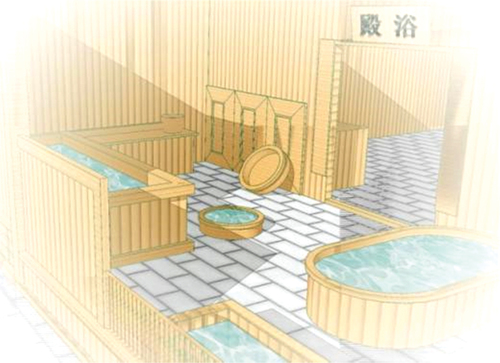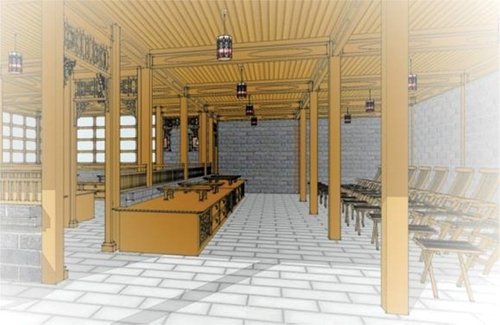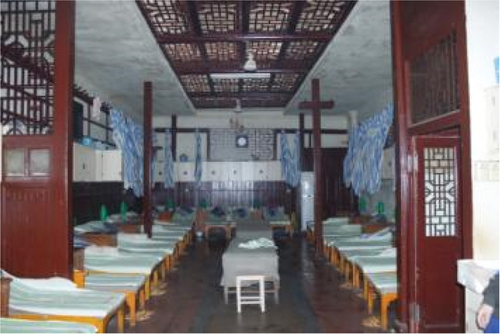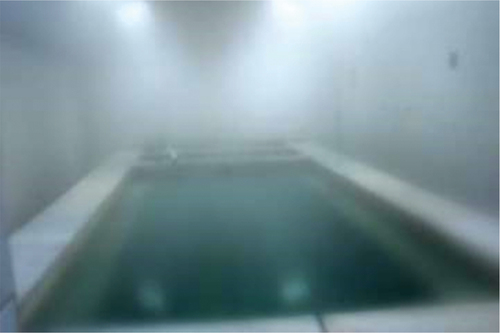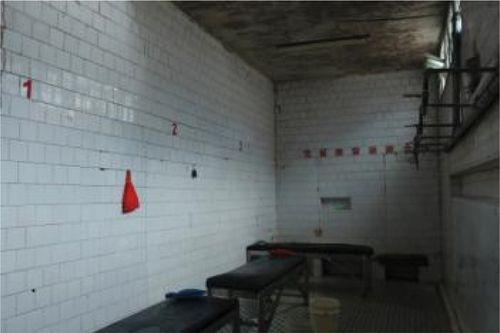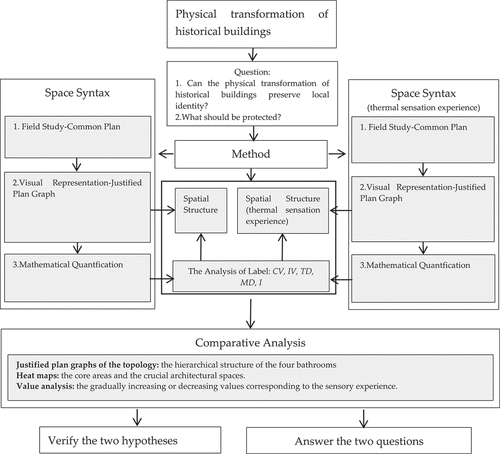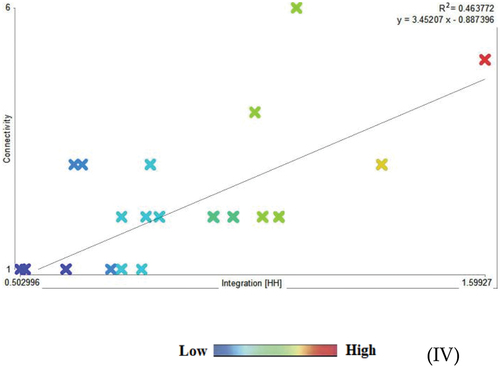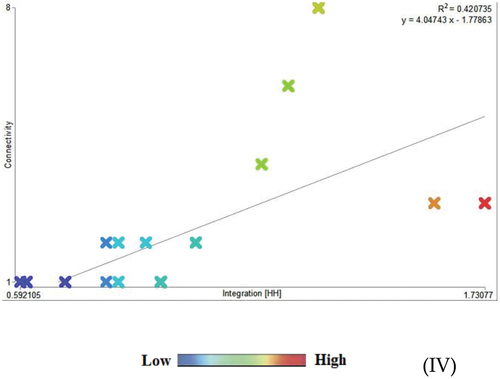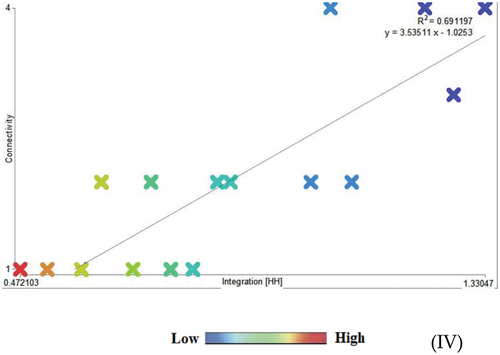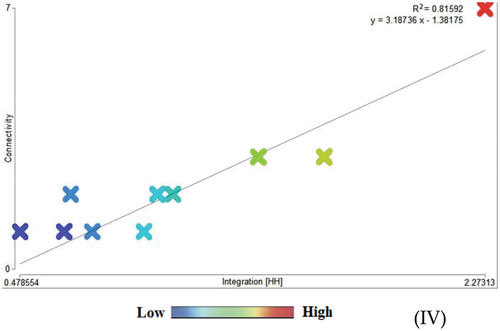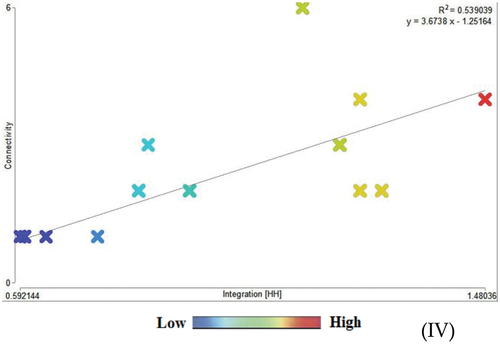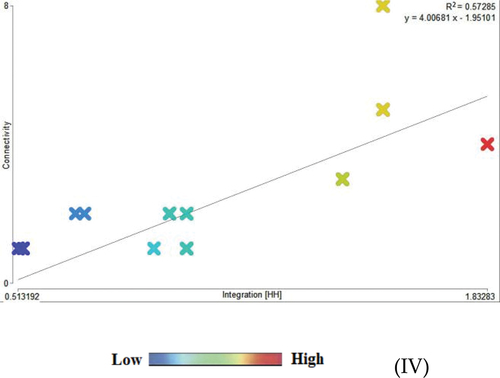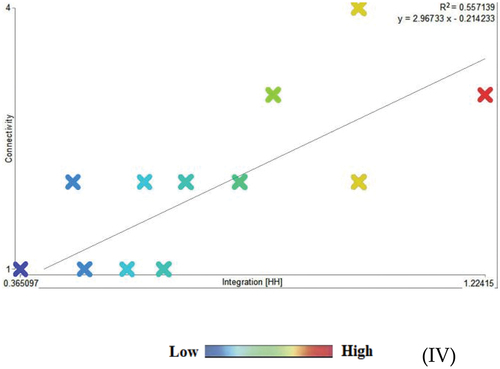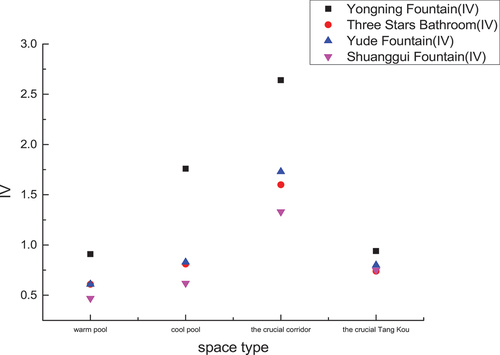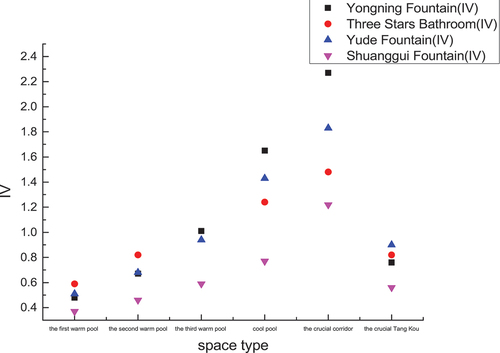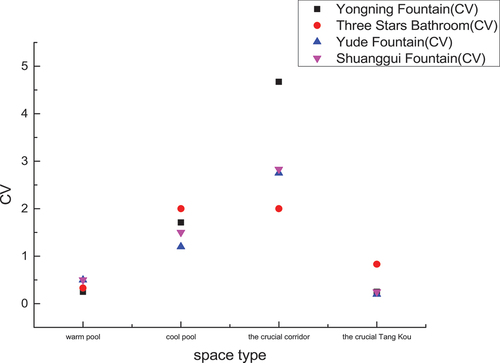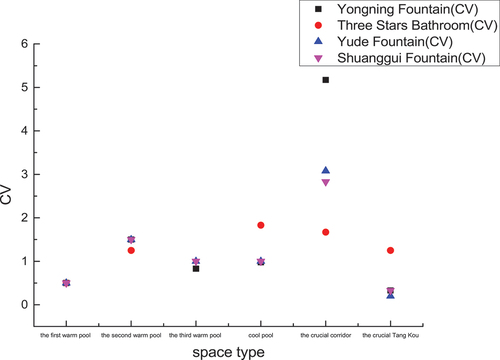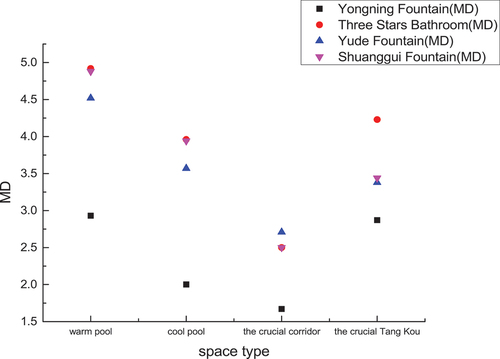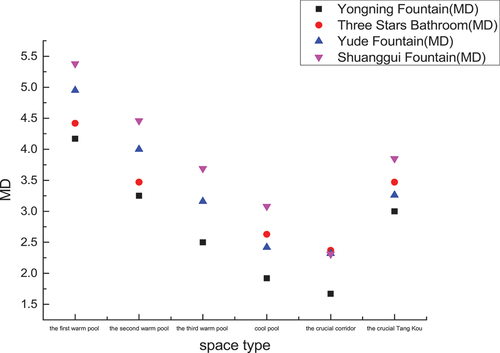 ?Mathematical formulae have been encoded as MathML and are displayed in this HTML version using MathJax in order to improve their display. Uncheck the box to turn MathJax off. This feature requires Javascript. Click on a formula to zoom.
?Mathematical formulae have been encoded as MathML and are displayed in this HTML version using MathJax in order to improve their display. Uncheck the box to turn MathJax off. This feature requires Javascript. Click on a formula to zoom.ABSTRACT
Sensory experience is vital in creating a local identity in historical buildings and should ideally be conserved along with basic spatial structure. Hence, this study explores the relation between the spatial structure and thermal sensation experience by systematically analysing the space syntax of Yangzhou’s four old public bathrooms. In this space syntax analysis, the spatial depths of Yangzhou’s old public bathrooms are arranged in descending order of thermal sensation. This model is unique in that it considers the thermal sensation experience; the “warm pool” room with the highest temperature is considered the origin of the thermal sensation experience and carrier of the building. This proposed model that includes thermal sensory experience is then compared with the typical spatial structure model. The study’s results support the first hypothesis that the four old bathrooms have a similar spatial structure. Further, they support the second hypothesis that the analysis is more valuable and clear when the sensory experience is incorporated into space syntax analyses. This study proposes a new method that combines the sensory experience with space syntax analysis to determine what to protect and also evaluate whether historical buildings preserve the local identity.
1. Introduction
Implementing cultural and creative industries into historical blocks has become a global trend in urban regeneration, leading to the physical transformation of historical buildings (Zeng et al. Citation2020). In some cases, the main spatial structure and the sensory experience related to the structure of a historical building have been destroyed, but its old-fashioned frontage and decoration styles have been preserved. The question remains whether such physical transformation of historical buildings is acceptable. Some studies suggest a possible evaluation of the elementary space configuration deprived of all the decorative attachments using space syntax (Assassi and Mebarki Citation2021; Moayed and Turker Citation2021; Zeng et al. Citation2020; Zolfagharkhani and Ostwald Citation2021). In contrast, others recommend gathering social meaning directly from symbols and decorations (Nara Junior Citation2018). This study contends that the first approach may be preferable when a historical building has a unique internal structure and a unique sensory environment relying on it. Acceptance of the physical transformation of historical buildings depends on whether the local identity of which they are a part can be preserved. The physical transformation of historical buildings may not necessarily enhance the existing local identity, partly because the emotional experiences disappear with the original spatial structure (Psarra Citation2009; Zeng et al. Citation2020). Nonetheless, local identity is an internal factor deeply rooted in the nature of culture-led physical transformation of historical buildings and is the key to culture sustainability (Zeng et al. Citation2020). Hence, the sensory space experience plays a significant role in creating the local identity, which may be an internal source of sustainability.
Space syntax is a collective name for various techniques employed to analyse a plan’s topological and associated spatio-cognitive properties, including permeability and intelligibility (Hanson Citation1998; Hillier and Hanson Citation1984). The space syntax analysis usually refers to integration value (IV), relative asymmetry (RA), mean depth (MD), total depth (TD), and control value (CV), among others. In the analysis, a room is represented as a knot on the plan graph, while the elementary relations, namely, the direct permeability between cells, are represented as lines (Zeng et al. Citation2020). The spatial model built by the knots and the elementary relations helps evaluate the physical transformation of historical buildings. However, the spatial model may be meaningless without the sensory experience. Environmental stimuli provide a sensory space and generate various types of emotional experiences (Basyazici-Kulac and Ito-Alpturer Citation2013; Reddy, Chakrabarti, and Karmakar Citation2012). The sensory environments belong to regional social traditions and, by extension, cultural heritage (Baumanova Citation2020). Hence, space syntax must be combined with sensory environments. Archaeologists have applied and continue to develop new spatial analysis methods, such as space syntax and sensory archaeology (Goldstein and Sitek Citation2018). These methods help them gather new information from the logic of spatial organisation (Morton et al. Citation2012), and add flavour, scents, and sounds to the bare bones of site layouts and settlement patterns (Betts Citation2017; Hamilton et al. Citation2006). As these methods show, senses may play a significant role in the (re) constitution of cultural life (Fleisher and Norman Citation2016). For the same reason, a historical building exhibits unique sensory environments corresponding to its unique spatial structure, which should be addressed simultaneously. The fact that such a sensory environment is “unique” means that the spatial structure itself can create and control a main sensory experience. Sensory experiences can also give meaning to spatial structures, such as the visual sensory experience in Beijing’s traditional compounds, Yazd courtyard houses, Richard Neutra’s residential architecture, and house layouts in traditional desert settlements, and the kinaesthetic and visual sensory experience of the palatial complex at the Palace of Gede (Dawes, Lee, and Ostwald Citation2022; Alkhazmi Citation2017; Baumanova Citation2020; Zeng et al. Citation2020; Zolfagharkhani and Ostwald Citation2021).
In increasingly multi-cultural societies that are subject to the homogenising pressures of globalisation, what to protect is at the forefront of debates on historical preservation (Tweed and Sutherland Citation2007). An appropriate evaluation of a historical building’s situation or its physical transformation can help clarify this issue. Such an evaluation should involve the sensory space experience, especially for a historical building with a unique spatial structure that is closely related to the human senses. Some studies have begun addressing human sensations – including visual, auditory, and kinaesthetic aspects – and the spatial structure using space syntax (Dawes, Lee, and Ostwald Citation2022; Baumanova Citation2020; Fowler Citation2017; Laurence et al. Citation2011). For example, “Visual excitation” in Richard Neutra’s residential architecture is analysed using weighted graphs and centrality measures (Dawes, Lee, and Ostwald Citation2022).
The sensory space experience may help us better understand historical buildings’ spatial partitioning and material dimensions, which contribute to the creation of a local identity. However, the spatial structure and sensory space experience, and their unique relationship, remain under-researched. Many previous studies have focused on only one and failed to bridge the gap between them (Dawes, Ostwald, and Lee Citation2021; Derya Arslan and Ergener Citation2022; Kiseok Citation2022; Sabry Hegazi et al. Citation2022; Tarabieh et al. Citation2019; Yunitsyna and Shtepani Citation2022). Sensory perceptions can be seen as the feedback of various sensory stimuli, such as light, colour, shape, and volumetric geometry. The feedback is then integrated to form the whole image of the architectural space (Kiruthiga and Thirumaran Citation2017). Architectural space is regarded as a spatial carrier that involves various sensory stimuli, and sense and space are usually studied independently (Behrens and Mavromichalis Citation2017; Boix-Vilella et al. Citation2021; Rondini and Bertelli Citation2017). The few studies that focused on the relationship between architectural space and sensory perception (Imrie Citation2003; Lee Citation2022; Pallasmaa Citation2005; Samalavičius Citation2021) were typically conducted as a mechanical process and ignored the active role that spatial structure plays in emotional experience and the emotional experience’s meaning to the spatial structure. Such studies generally obtain their results about the sensory experience mechanically from a general space syntax analysis, which cannot lead to a deep understanding of the sensory experience. In addition, regarding the perception type, various studies have focused mainly on the visual and kinaesthetic sensations and tended to either avoid the “sense” topic or refer to it unsystematically (Fleisher and Norman Citation2016). Some unique sensations, such as the tactile sensory sensation, are seldom referenced in previous studies.
To bridge this research gap, the present study addresses the old public bathrooms in Yangzhou – historic buildings with a unique tactile sensory experience (thermal sensation) based on a unique spatial structure – that prospered during the Qing Dynasty. The old public bathrooms and bath culture associated with them form part of Yangzhou’s cultural heritage. This study proposes two hypotheses: (1) a similar spatial structure exists in the four old bathrooms; and (2) analysis becomes clearer and more valuable when the sensory experience is incorporated into space syntax analyses, enhancing the current understanding of the spatial structure.
2. Materials and methods
2.1. Study area
Situated in Jiangsu Province in the middle and lower reaches of the Yangtze River, Yangzhou has a latitude of 31°56′–33°25′N, longitude of 119°01′-119°54′E, and an average sea level elevation of 4~8 m. With part of the transition zone between a subtropical monsoon humid climate and a temperate monsoon climate, it has an annual mean temperature of 14.8–15.3℃ (). Yangzhou’s bath culture even has a crucial influence on modern local life. A man’s daily life in Yangzhou comprises two elements. Men enjoy tasting Yangzhou’s dim sum and tea in the morning and a hot bath in the evening (Deping Citation2016). The traditional saying “Water inside in day time, and water outside at night time” is well known, painting a vivid picture of this lifestyle. “Water inside” refers to Yangzhou’s dim sum, a juicy steaming dumpling, while “water outside” means taking a hot bath.
Figure 2. Location of the four old public bathrooms in Yangzhou.
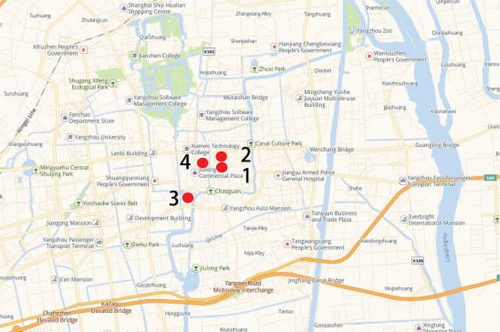
Yangzhou’s old public bathrooms have three characteristics as historical buildings. First, they exhibit a complicated spatial structure that provide a wonderful sensory experience. Second, the sensory experience obtained here is part of the cultural heritage. Yangzhou’s bath culture is a provincial intangible cultural heritage. Third, the thermal sensation obtained is the primary sensation in Yangzhou’s old public bathrooms, which differs from other buildings that consider vision the primary sensation.
The proposed spatial investigation addresses four of Yangzhou’s old public bathrooms, including “Yongning Fountain”, “Shuanggui Fountain”, “Yude Fountain”, and “Three Stars Bathroom” (). These four bathrooms still have ‘Di Long‘, the traditional underfloor heating system operated by flue pipes. Besides the “Di Long”, the “warm pool” room and the “Tang Kou” room are also representative features of the public bathrooms in the Qing dynasty. The ancient paintings of the “warm pool” and “Tang Kou” rooms in the book “A Record of Pleasure-boat in Yangzhou” are redrawn () (Douzhuan Citation2001).
Table 1. Name, construction time and area of the houses.
Yangzhou’s old public bathrooms feature a “warm pool” room, “cool pool” room, “Tang Kou” room, entrance, corridor, and boiler room. When a client enters the old bathroom, a waiter leads him into the “Tang Kou” room, where the client is provided with a cup of tea, hot towel, and bed to rest before a bath (). After a short break, the client removes his clothes and the waiter covers him with a bath towel. Then, the client enters the “warm pool” room through the corridor and, later, the “cool pool” room. The “warm pool” room generally features three pools: “the first warm pool”, “the second warm pool”, and “the third warm pool”. ‘The first and second warm pools are small, but the third is large. The first warm pool has the hottest water temperature, ranging from 60℃ to 70℃. The second warm pool has a fairly hot water temperature of approximately 55℃. The third warm pool has a warm water temperature, ranging from 45℃ to 50℃ (). In the past, a fourth warm pool, which had the lowest temperature, was specially built for boys and included in the “warm pool” room; however, it was dismantled in the late 1990s for hygiene reasons. The first and second warm pools are covered with a wooden lattice to prevent people from falling into the hot water and being injured.
In the “warm pool” room, the clients can soak one end of a long towel in the first warm pool through the wooden lattice and use the warmed towel to warm their head, back, or feet or be assisted by the waiter. Then, they can lie on the wooden lattice to enjoy a sauna. If the first warm pool feels too hot, they can use the second warm pool in the same way. After using the first and second warm pools, they likely enter the third warm pool, where the water temperature is lower. In the third warm pool, they can share the bath with others. If the clients complete their bath or feel too hot in the “warm pool” room, they can move to the “cool pool” room, where they find leather beds and shower nozzles (). In this room, the clients may enjoy various services, such as getting a rubdown with a damp towel, taking a shower, or resting. Finally, they return to the “Tang Kou” room for a massage, pedicure, or good sleep.
2.2. Methods
This study uses space syntax as a systematic method to investigate, describe, analyse, and classify spatial structure and sensory experience. This study focuses on the thermal sensory experience, which is uncommon in space syntax analysis. This approach helps show the traditional building typology concisely and clearly ().
2.2.1. Visual representation
A building can be represented as a justified plan graph obtained from the common plan of the building (Zeng et al. Citation2020). The room of Yangzhou’s old public bathroom is represented as a knot on the plan graph, while the elementary relation is represented as lines. For the spatial structure analysis, the space outside the building is considered the carrier of the building and is represented as the root-knot “X” (). Previous studies have indicated that the body’s temperature declines to its lowest approximately six minutes after a bath (HOKOI and Yonghui Citation2019). However, Yangzhou’s old public bathroom can decelerate the lowering of body temperature through spatial depth, arranged in the descending order of thermal sensation. Because the water temperature of the first warm pool in the “warm pool” room is the highest, it is considered the origin of the thermal sensation experience and is represented as the root-knot. This method helps clarify the spatial structure in affiliation with tactile experience (thermal sensation). All the knots are arranged in order of depth value, except the “boiler room”, which does not correlate with the thermal sensation experience. The labels of the rooms are abbreviated as warm pool (wp), Tang Kou (tk), cool pool (cp), entrance (en), corridor (cr), boiler room (br), first warm pool (1p), second warm pool (2p), and third warm pool (3p).
Figure 9. Common plan graph, justified plan graph, and connectivity heat map of integration levels of the “Yongning Fountain”: (a) an architectural plan with 15 rooms, annotated as 1–15, and with the exterior (X) as a carrier; (b) justified graph of the topology of the plan, relative to the exterior; (c) connectivity heat map of integration levels.

2.2.2. Quantification
In a convex plan graph, the total depth (TD), mean depth (MD), control value (CV), intelligibility (I), and integration value (IV) can be calculated for each node. The total depth (TD) suggests the connectivity distance, which is an indication of the distance between a room and other rooms (HOKOI and Yonghui Citation2019):
The MD is the average depth for each node, representing the degree of isolation of the spaces (Klarqvist Citation1993):
Where k is the number of nodes.
CV measures the extent to which one node influences all others. Klarqvist has also described it as “a dynamic local measure” that defines “the degree to which a space controls access to its immediate neighbours” (Douzhuan Citation2001):
I is defined as Pearson’s correlation between integration and the connectivity values of all vertices. It indicates how easy it is to navigate an environment, reflecting the overall clarity of the system as perceived by a user inside of it (Klarqvist Citation1993).
RA is a measure of the relative isolation of a node within the graph (Zolfagharkhani and Ostwald Citation2021). To undertake a comparison between different sized graphs (building plans with different numbers of rooms), RRA normalizes the measures relative to an idealized diamond-graph D, for k number of spaces (Peponis and Wineman Citation2002; Tavassoli Citation2019). Once RRA is determined, a normalized integration (iRRA or IV) measure can also be developed to compare properties of different sized graphs. IV is based on determining the shortest distance from a particular graph node to every other graph node, where the distance is counted as the minimum number of edges that must be traversed (Dawes, Lee, and Ostwald Citation2022). Additionally, the dimension of symmetry-asymmetry can be measured by IV or RRA (Zeng et al. Citation2020).
where Dk is the RA of a diamond-shaped system.
3. Results
3.1. Spatial type of Yangzhou’s traditional old public bathrooms
The common plan, justified plan graph, essential syntactic values of typical cases, connectivity heat map of integration levels, and intelligibility chart of four of Yangzhou’s old public bathrooms are reported in . Various special knots are identified by the black circles in the justified plan graph, which are recognised by the space syntax analysis. In addition, shows the values of MD, TD, CV, and IV for the main spaces in four of Yangzhou’s old public bathrooms.
Figure 10. Common plan graph, justified plan graph and connectivity heat map of integration levels of the “Three Stars Bathroom”: (a) an architectural plan with 26 rooms, annotated as 1–26 and with the exterior (X) as a carrier; (b) justified graph of the topology of the plan, relative to the exterior; (c) connectivity heat map of integration levels.

Figure 11. Common plan graph, justified plan graph and connectivity heat map of integration levels of the “Yude Fountain”: (a) an architectural plan with 20 rooms, annotated as 1–20 and with the exterior (X) as a carrier; (b) justified graph of the topology of the plan, relative to the exterior; (c) connectivity heat map of integration levels.
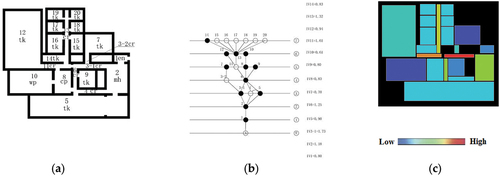
Figure 12. Common plan graph, justified plan graph and connectivity heat map of integration levels of the “Shuanggui Fountain”: (a) an architectural plan with 16 rooms, annotated as 1–16 and with the exterior (X) as a carrier; (b) justified graph of the topology of the plan, relative to the exterior; (c) connectivity heat map of integration levels.

Table 2. Results for hypothesis 1-spatial type.
3.1.1. Control value
The study’s results indicate that the four main corridors in the four cases exhibit higher CVs (CV in corridor 6 in “Yongning Fountain” = 4.67, CV of corridor 7 in “Shuanggui Fountain” = 2.83, CV of corridor 6 in “Yude Fountain” = 2.75, followed by the CV of corridor 2 in “Three Stars Bathroom” = 2.00). Although corridor 13 in “Yude Fountain” (CV = 7.33) and corridor 4 in “Three Stars Bathroom” (CV = 5.20) both have a higher control value, their role is not particularly significant (). The numerous Tang Kou rooms on both sides lead to a higher CV and have a limited impact on the building. Notably, the four main corridors have a similar location between “Tang Kou” and the “warm pool” (). This result suggests that the main corridor between “Tang Kou” and the “warm pool” in four of Yangzhou’s old public bathrooms generally has the most substantial influence over the spatial structure.
Regarding the CV of the “warm pool” and “cool pool” rooms, the results of the four cases are similar. The CVs of the “warm pool” rooms are much lower than those of the “cool pool” room and are nearly the lowest among all rooms in the corresponding bathroom. Furthermore, the CVs of the four “warm pool” rooms are very close (CV of the “warm pool” room in “Yude Fountain” = 0.50, CV of the “warm pool” room in “Shuanggui Fountain” = 0.50, CV of the “warm pool” room in “Three Stars Bathroom” = 0.33, followed by the CV of the “warm pool” room in “Yongning Fountain” = 0.25). All four “cool pool” rooms have higher control values, and these values are also very close (CV of the “cool pool” room in “Three Stars Bathroom” = 2.00, CV of the “cool pool” room in “Yongning Fountain” = 1.71, CV of the “cool pool” room in “Shuanggui Fountain” = 1.50, followed by the CV of the “cool pool” room in “Yude Fountain” = 1.20) (, ).
Regarding “Tang Kou” room, most of its CV values are close and below 0.5 (, ).
3.1.2. Integration, mean depth, and total depth
The results indicate that the main corridors in the four cases have higher IVs (IV of corridor 6 in “Yongning Fountain” = 2.64, IV of corridor 3–1 and corridor 11 in “Yude Fountain” = 2.24/2.33, IV of corridor 2 in “Three Stars Bathroom” = 1.60, followed by the IV of corridors 5, 7, and 8 in “Shuanggui Fountain” = 1.33/1.22/1.27). They also exhibit the lowest MDs (MD of corridor 6 in “Yongning Fountain” = 1.67, MDs of corridor 3–1 and corridor 11 in “Yude Fountain” = 1.73/1.61, MD of corridor 2 in “Three Stars Bathroom” = 2.50, followed by the MDs of corridors 5, 7, and 8 in “Shuanggui Fountain” = 2.38/2.50/2.44)). In addition, they have the lowest TDs (TD of corridor 6 in “Yongning Fountain” = 25, TDs of corridor 3–1 and corridor 11 in “Yude Fountain” = 47/49, TD of corridor 2 in “Three Stars Bathroom” = 65, followed by the TDs of corridors 5, 7, and 8 in “Shuanggui Fountain” = 38/40/39) (, ). Situated between “Tang Kou” and the “warm pool” room, these main corridors have a similar location. The main corridors between “Tang Kou” and the “warm pool” in these four old public bathrooms of Yangzhou generally represent the relative centrality of spaces and have the shortest distance to the “warm pool”. They are public spaces where clients are more likely to meet.
Regarding the IVs of the “warm pool” and “cool pool” rooms, the results of the four cases are similar. The IV of the “warm pool” room is much lower than that of the “cool pool” room. It is nearly the lowest among all rooms in the corresponding bathroom (IV of “warm pool” in “Yongning Fountain” = 0.91, IV of “warm pool” in “Yude Fountain” = 0.61, IV of “warm pool” in “Three Stars Bathroom” = 0.61, followed by the IV of “warm pool” in “Shuanggui Fountain” = 0.47). Moreover, the IVs of the four “warm pool” rooms are very close. In addition, the four “warm pool” rooms feature the highest MDs (MD of the “warm pool” room in “Three Stars Bathroom” = 4.92, MD of the “warm pool” room in “Shuanggui Fountain” = 4.88, MD of the “warm pool” room in “Yude Fountain” = 4.52, followed by the MD of the “warm pool” room in “Yongning Fountain” = 2.93) and have the highest TDs (TD of the “warm pool” room in “Three Stars Bathroom” = 128, TD of the “warm pool” room in “Yude Fountain” = 95, TD of the “warm pool” room in “Shuanggui Fountain” = 78, followed by the TD of the “warm pool” room in “Yongning Fountain” = 44) (, ). These results suggest that the “warm pool” rooms in the four bathrooms are segregated.
3.1.3. Intelligibility
The I of “Yongning Fountain” (I = 0.86) and “Shuanggui Fountain” (I = 0.69) is above 0.60. In contrast, the I of “Three Stars Bathroom” (I = 0.46) and “Yude Fountain” (I = 0.42) is below 0.60, in part because the “Tang Kou” rooms of the latter two bathrooms have a higher MD value (, ). I exceeding 0.60 may be considered high (Dawes, Lee, and Ostwald Citation2022), as in “Yongning Fountain” and “Shuanggui Fountain”.
3.2. Spatial type in affiliation with the thermal sensation experience of Yangzhou’s traditional old public bathrooms
The justified plan graph, essential syntactic values of typical cases, connectivity heat map of integration levels, and intelligibility chart of the four old public bathrooms of Yangzhou, in affiliation with thermal sensation experiences, are reported in and . The thermal sensation experience focuses on the “warm pool” room, “cool pool” room, main corridor that connects the “cool pool” to the “Tang Kou” room, and larger “Tang Kou” room or “Tang Kou” room in the special location. Spaces irrelevant to the thermal sensation experience are removed, including the entrance, secondary corridor, and boiler room.
Figure 17. Thermal sensation experience plan graph, justified plan graph and connectivity heat map of integration levels of “Yongning Fountain”: (a) an architectural plan with the 8–1(1p) as a carrier; (b) justified graph of the topology of the plan, relative to the 8–1 (1p); (c) connectivity heat map of integration levels.

Figure 18. The thermal sensation experience plan graph, justified plan graph and connectivity heat map of integration levels of “Three Stars Bathroom”: (a) an architectural plan with the 17–1(1p) as a carrier; (b) justified graph of the topology of the plan, relative to the 17–1 (1p); (c) connectivity heat map of integration levels.

Figure 19. The thermal sensation experience plan graph, justified plan graph and connectivity heat map of integration levels of “Yude Fountain”: (a) an architectural plan with the 10–1(1p) as a carrier; (b) justified graph of the topology of the plan, relative to the 10–1 (1p); (c) connectivity heat map of integration levels.
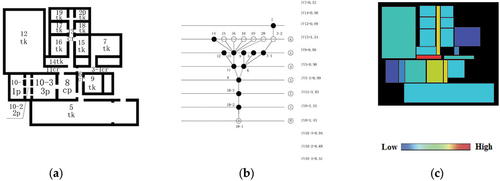
Figure 20. The thermal sensation experience plan graph, justified plan graph and connectivity heat map of integration levels of “Shuanggui Fountain”: (a) an architectural plan with the 15–1(1p) as a carrier; (b) justified graph of the topology of the plan, relative to the 15–1 (1p); (c) connectivity heat map of integration levels.

Table 3. Results for hypothesis 2– spatial type in affiliation with the thermal sensation experience.
3.2.1. Control value
The main corridors in the four cases exhibit higher CVs (CV of corridor 6 in the “Yude Fountain” = 3.08, CV of corridor 6 in “Yongning Fountain” = 5.17, CV of corridor 7 in “Shuanggui Fountain” = 2.33, followed by the IV of corridor 4 in “Three Stars Bathroom” = 1.67). Although corridor 13 in “Yude Fountain” (CV = 7.25) and corridor 4 in “Three Stars Bathroom” (CV = 5.25) have a higher CV, their role is not particularly significant for the same reason as in the previous analysis ( and ).
Regarding the CV of the “warm pool” and “cool pool”, the results of the four cases are similar. The CVs of all “the first warm pools” (8–1, 17–1, 10–1 and 15–1) are the same (CV = 0.50). The CVs of all “the second warm pools” (8–2, 17–2, 10–2 and 15–2) are very close, and three are the same (CV = 1.50). The CVs of “the third warm pools” are very close, and three are the same (CV = 0.83). The four “cool pool” rooms all have very close CVs (CV ≈1.00), except the “cool pool” 9 in “Three Stars Bathroom”. The CV of this “cool pool” 9 is higher than that of other “cool pools” because it connects more knots, including two corridors and one “Tang Kou” (, ).
For “Tang Kou”, most CVs are close and below 0.5 (, ).
3.2.2. Integration value, mean depth, and total depth
The main corridors in the four cases have higher IVs (IV of corridor 6 in “Yongning Fountain” = 2.27, IV of corridor 11 in “Yude Fountain” = 1.83, IV of corridor 2 in “Three Stars Bathroom” = 1.48, followed by the IV of corridor 8 in “Shuanggui Fountain” = 1.22), but the lowest MDs (MD of corridor 6 in “Yongning Fountain” = 1.67, MD of corridor 11 in “Yude Fountain” = 2.11, MD of corridor 2 in “Three Stars Bathroom” = 2.37, followed by the MD of corridor 8 in “Shuanggui Fountain” = 2.31). They also have the lowest TDs (TD of corridor 6 in “Yongning Fountain” = 20, TD of corridor 11 in “Yude Fountain” = 40, TD of corridor 2 in “Three Stars Bathroom” = 45, followed by the TD of corridor 8 in “Shuanggui Fountain” = 30) (, ). Most of the IVs, MDs, and TDs of the main corridors are very close.
Regarding the IVs of the “warm pool” and “cool pool”, the results of the four cases are similar. The IV of “the first warm pool” (1p) is much lower than that of the “cool pool” and is nearly the lowest one among all rooms in the corresponding bathroom (IV of “the first warm pool” 17–1 in “Three Stars Bathroom” = 0.59, IV of “the first warm pool” 10–1 in “Yude Fountain” = 0.51, IV of “the first warm pool” 8–1 in “Yongning Fountain” = 0.48, followed by the IV of “the first warm pool” 15–1 in “Shuanggui Fountain” = 0.37). All the IVs of “the first warm pool” are very close. However, all “the first warm pools” have the highest MDs (MD of “the first warm pool” 15–1 in “Shuanggui Fountain” = 5.38, MD of “the first warm pool” 10–1 in “Yude Fountain” = 4.95, MD of the first warm pool’ 17–1 in “Three Stars Bathroom” = 4.42, followed by the MD of “the first warm pool” 8–1 in “Yongning Fountain” = 4.17) and the highest TDs (TD of “the first warm pool” 17–1 in “Three Stars Bathroom” = 84, TD of “the first warm pool” 10–1 in “Yude Fountain” = 94, TD of “the first warm pool” 15–1 in “Shuanggui Fountain” = 70, followed by the TD of “the first warm pool” 8–1 in “Yongning Fountain” = 50). Most of the MDs and TDs of “the first warm pool” are very close. Generally, the IV of “the third warm pool” is higher than that of “the second warm pool”, and the value of “the second warm pool” is higher than that of “the first warm pool” in each bathroom. These results suggest that “the first warm pool” rooms in the four bathrooms are mostly segregated ( and ).
3.2.3. Intelligibility
The I of “Yongning Fountain” (I = 0.82) and “Shuanggui Fountain” (I = 0.67) is above 0.60, and the I of “Three Stars Bathroom” (I = 0.53) and “Yude Fountain” (I = 0.57) is close to 0.60 (, ).
4. Discussion
4.1. Common spatial features of the four bathrooms
The syntactical value of the crucial architectural space may be more critical than the mean syntactical value in some respects because the choice of what to protect is key for historic buildings, especially for their physical transformation (Tweed and Sutherland Citation2007). The inequality genotype arising from the data is as follows: Main Corridor (IV) > Cool pool (IV) > Main Tang Kou (IV) > Warm poor (IV) (Bafna Citation2001) (). The sensory experience and the space syntax analysis can identify these primary spaces. The CV in the analysis has a similar trend, but the MD has a converse trend ().
presents the CV, IV, MD, and TD heat maps of the four bathrooms with the exterior (X) and “first warm pool” (1p) as carriers (red indicates the highest level, and dark blue represents the lowest level). These heat maps show the special spatial core area with the “warm pool” room, “cool pool” room, and spaces around them. The main corridors between the “Tang Kou” room and the “warm pool” room exhibit the highest IV and CV and the lowest MD and TD, followed by the “cool pool” room. The “warm pool” room exhibits the lowest IV and CV and the highest MD and TD. This common spatial feature of the four bathrooms is apparent in these heat maps, and all the close values (the CV of “warm pool” rooms, CV of “cool pool” rooms, and IV of “warm pool” rooms) indicate the common spatial feature.
Table 4. Common heat maps with the exterior (X) as the carrier and the control heat maps with “the first warm pool” (1p) as the carrier.
Therefore, these results support the first hypothesis.
4.2. Analysis in affiliation with the thermal sensation experience
The justified plan graphs of the topology in affiliation with the thermal sensation experience have more depth than the common justified plan graphs, especially for the experience from “the first warm pool” to the “cool pool”.
Compared with the common control heat maps and common analysis of the CV, the control heat maps with “the first warm pool” (1p) as the carrier and the analysis of the CV about the sensory experience demonstrate the higher control level of the “warm pool” room and the more detail structure of the sensory space (, ). reflects the gradually increasing values (except for the CV of “the second warm pool”) corresponding to the order of the sensory experience, namely, from the segregated “first warm pool” to the public “cool pool” room. The CV of “the second warm pool” is much higher than that of “the first warm pool” and “the third warm pool”, partly because its two sides connect “the first warm pool” and “the third warm pool”. Furthermore, in the space syntax analysis in affiliation with the thermal sensation experience, “the first warm pool”, “the second warm pool”, “the third warm pool”, and the “cool pool” room have nearly the same CVs in the four bathrooms, in contrast with the different CVs in the common syntax analysis. Regarding the CV of the main corridors and “Tang Kou” rooms, the differences among the four bathrooms in affiliation with the thermal sensation experience analysis are only slightly higher than those among the four bathrooms in the common analysis.
Compared with the common integration heat maps and the common analysis of the IVs, the integration heat maps with “the first warm pool” (1p) as the carrier and the analysis of IV about the sensory experience demonstrate the higher integration level of “the cool pool” room and only one main corridor, and the more detailed structure of the sensory space (, ). reflects the gradually increasing value corresponding to the order of the sensory experience, from the segregated “the first warm pool” space to the public “cool pool” room. Regarding the IV of all kinds of main spaces, the differences among the four bathrooms affiliated with the thermal sensation experience analysis are mostly lower than those among the four bathrooms in the common analysis, especially for “the first warm pool”. The main corridor of “Yongning Fountain” has the highest IV among the four bathrooms, partly because the main corridor is the only main space connecting the “warm pool” and “cool pool” with the “Tang Kou” rooms ().
Compared with the common MD and TD heat maps and analysis of the MD value, the MD and TD heat maps of the four bathrooms with “the first warm pool” (1p) as the carrier and the analysis of the MD value about the sensory experience demonstrate the lower depth level of “the cool pool” room and main surrounding corridors, higher depth level of “the first warm pool”, and detailed structure of the sensory space (, ). reflects the gradually decreasing values corresponding to the order of the sensory experience from the segregated “warm pool” room to the public “cool pool” room. Regarding the MD values of all kinds of main spaces, the differences among the four bathrooms in affiliation with the thermal sensation experience analysis are lower than those in the common analysis.
Compared with the common spatial structure’s intelligibility, the spatial structure’s intelligibility in affiliation with the thermal sensation experience for the “Three Stars Bathroom” and “Yude Fountain” is higher and very close to 0.6, and the intelligibility of the spatial structure in affiliation with the thermal sensation experience for the other two bathrooms is slightly different (, , ). This result indicates that the movement induced by tactile stimuli provides a good understanding of the spatial configuration. In other words, the thermal sensation enhances visual perception, a conclusion similar to the one reached by several other studies (Baumanova and Smejda Citation2017). For example, the analysis of Gede palace reveals an instance in which one kind of sensory property enhances or contradicts the effect of another, and it is not observable by analyses focusing on any one sense alone (Baumanova Citation2020).
Therefore, these results support the second hypothesis. When the sensory experience is incorporated into space syntax analyses, the relationships of the main spaces can be expressed clearly, and the interference resulting from other irrelevant architectural spaces is reduced. This approach contributes to the understanding of spatial structure and helps obtain feature abstraction from different study cases, supporting the view that the built environment consists of tangible architectural and natural features and intangible spaces within those structures (Baumanova Citation2016; Low Citation2016).
Overall, the results may be partly validated depending on the comparative study. The two studies involving the four bathroom cases (common study and the study based on the sensory experience) exhibit a similar hierarchical structure, core area, and crucial architectural space. The CVs, IVs, and MDs of the different spaces in the four bathrooms display a definite similar value or a similar increasing or decreasing trend in the order of the sensory experience in the two studies. In addition, these results are slightly similar to those of other previous studies that combine the space syntax technique with sensory perception. For example, several studies directly use the space syntax technique to judge whether the visual stimulus in a room is great or not and use intelligibility to evaluate the ability to gain an efficient understanding of the spatial configuration of a building (Hillier et al. Citation1987; Ostwald and Dawes Citation2018). In one specific study, the “average closeness” of a living room (8.8816) is significantly greater than that of a main bedroom (3.2096), which indicates that the visual stimuli in the living room is greater than that in the main bedroom. The intelligibility value below 0.60 indicates low intelligibility, which corresponds with the results of this study (Dawes, Lee, and Ostwald Citation2022). Furthermore, several previous studies not only directly apply a space syntax technique (visibility) to clarify the impact of spatio-visual properties of cultural heritage, but also employ a users’ perception test to verify the analysis results. Results of this test identify a strong positive correlation between users’ perception and visibility of paths (0.716) and indicate that the isovist measurement is a suitable variable to assess, by which human perceptions can be analysed (Bazazzadeh et al. Citation2020). Indeed, this study differs from previous studies in that it recognizes the sensory experience as a vital element to lead a space syntax analysis; other studies consider sensory perception as a result of a space syntax analysis.
Significantly, the areas of “Three Stars Bathroom”, “Yude Fountain”, and “Shuanggui Fountain” are close, but the area of “Yongning Fountain” is smaller than that of the other three old bathrooms. Although the areas of the four old bathrooms are not identical, the effect of the area size of the four old bathrooms on the syntax analysis is small. The reasons are as follows: First, all the CVs, IVs, and MDs of the different spaces in the four bathrooms display a definite similar increasing or decreasing trend in the order of the sensory experience (). Most of the CVs, IVs, MDs, and TDs of the different spaces in the four bathrooms are close to each other, especially in the analyses in affiliation with the thermal sensation experience (, ). For example, “the first warm pool”, “the second warm pool”, “the third warm pool”, and the “cool pool” room in the four bathrooms have nearly the same CVs, and most of the CVs of the “Tang Kou” rooms in the four bathrooms are close and below 0.5. All IVs of “the first warm pool” are also very close. Second, the effect of the very high CVs of corridor 13 in “Yude Fountain” and corridor 4 in “Three Stars Bathroom” due to the many “Tang Kou” rooms on both sides of them is avoided in the analysis because of their limited roles. Third, the IV measure was originally developed for comparing properties of different sized graphs. Therefore, this method contributes to preserving the spatial structure and sensory environments in different sizes.
5. Conclusions
Using the space syntax analysis method in affiliation with sensory experience, this study examines two hypotheses about the planning of the “Yongning Fountain”, “Three Stars Bathroom”, “Yude Fountain”, and “Shuanggui Fountain”.
The first hypothesis explores whether a similar spatial structure exists in Yangzhou’s traditional old public bathrooms. The justified plan graphs of the topology reflect the similarity of the hierarchical structure of the four bathrooms, and the heat maps show the similarity of the core areas and highlight the same crucial architectural spaces. The value analysis indicates the gradually increasing or decreasing values corresponding to the sensory experience. The results indicate a clear similar spatial structure of the four bathrooms.
The second hypothesis explores whether the analysis is clearer and more valuable when the sensory experience is incorporated into space syntax analyses and contributes to the current understanding of the spatial structure. The thermal sensation experience is closely related to the spatial series and spatial isolation level. It can be fully expressed by the gradually increasing or decreasing values corresponding to the sensory experience in the value analysis. Then, the structure of the sensory space can be shown in detail (). The justified plan graphs of the topology in affiliation with the thermal sensation experience reflect a much more complex hierarchy of spaces. The heat maps, in affiliation with the thermal sensation experience, reflect the core area more clearly and highlight the valuable architectural spaces. The spatial intelligibility of the four bathrooms in affiliation with the thermal sensation experience is close to or above normal spatial intelligibility (namely, 0.6). The results demonstrate that the thermal sensation experience contributes to an efficient understanding of the spatial structure.
The results indicate that the sensory experience can be incorporated into space syntax analyses. This approach helps show the spatial structure and relationship within the spatial structure in detail, which is closely related to the sensory experience. In addition, it helps reduce the interferences of irrelevant architectural spaces. It also focuses on the thermal sensation from the traditional visual sensation, and not only supplements the study of the sensory experience but is also useful for other sensory experience analyses. Overall, this approach helps determine what to protect for the built environment, which consists of tangible architectural structures as well as intangible spaces within those structures, including the hierarchical structure, core area, crucial architectural space, and effect of the architectural structure on the sensory experience. Furthermore, this approach can help evaluate whether the physical transformation of historical buildings can help preserve the local identity or the situation of historical buildings, as shown by the analysis results.
Considering visual, auditory, olfactory, and kinaesthetic sensation experiences that can simultaneously exist in a built environment, it is a challenge to combine these different sensory experiences into an integrated space syntax analysis. More research should be conducted in the future for further analysis.
Acknowledgment
The authors are indebted to their colleagues who have assisted in the collection of information about the old public bathrooms in Yangzhou. The research presented here could not have been undertaken without this help. We would like to thank Editage (www.editage.cn) for English language editing.
Disclosure statement
No potential conflict of interest was reported by the authors.
Additional information
Funding
Notes on contributors
Xing Chen
Xing Chen is Ph.D. Assistant Professor at Yangzhou University (College of Architectural Science and Engineering) and member of Research Institute of China Grand Canal.
Wangteng Duan
Wangteng Duan is present master at Yangzhou University (College of Architectural Science and Engineering).
Yi Liu
Yi Liu is Ph.D. Assistant Professor at Yangzhou University (College of Electrical, Energy and Power Engineering).
Shengcai Li
Shengcai Li is Ph.D. Professor at Yangzhou University (College of Architectural Science and Engineering).
Shunyu Sui
Shunyu Sui is present master at Capital Normal University (School of Political Science and Law).
References
- Alkhazmi, H. M. 2017. “Investigating the Visual Privacy on Houses Layouts in Traditional Desert Settlement of Ghadames City- Libya- by Using Space Syntax Analysis.” International Journal of Applied Engineering Research 12 (19): 8941–8951.
- Assassi, A., and A. Mebarki. 2021. “Spatial Configuration Analysis via Digital Tools of the Archeological Roman Town Timgad, Algeria.” Mediterranean Archaeology & Archaeometry 21: 117–130. https://doi.org/10.5281/zenodo.4284429.
- Bafna, S. 2001. “Geometric Intuitions of Genotypes.” In: Proceedings of the third international symposium on space syntax, Atlanta, USA. 20.1–20.16.
- Basyazici-Kulac, B., M. Ito-Alpturer. A Phenomenological Study of Spatial Experiences without Sight and Critique of Visual Dominance in Architecture. In Proceedings of the EAEA-11 Conference 2013, (Track 2) Experiential Simulation: The Sensory Perception 168 of the Built Environment, Milano, Italy, September 25–28, 2013.
- Baumanova, M. 2016. “Space Matters: A Reflection on Archaeological Theory and Method for Interpreting the Materiality of Space.” Interdisciplinaria Archaeologica: Natural Sciences in Archaeology 7 (2/2016): 209–216. https://doi.org/10.24916/iansa.2016.2.6.
- Baumanova, M. 2020. “Sensory Synaesthesia: Combined Analyses Based on Space Syntax in African Urban Contexts.” African Archaeological Review 37 (1): 125–141. https://doi.org/10.1007/s10437-020-09368-9.
- Baumanova, M., and L. Smejda. 2017. “Structural Dynamics of Spatial Complexity at the ‘Palace of Gede’, Kenya.” Azania: Archaeological Research in Africa 52 (1): 71–99. https://doi.org/10.1080/0067270X.2017.1283095.
- Bazazzadeh, H., A. Nadolny, K. Attarian, B. Safar Ali Najar, and S. S. Hashemi Safaei. 2020. “Promoting Sustainable Development of Cultural Assets by Improving Users’ Perception Through Space Configuration; Case Study: The Industrial Heritage Site.” Sustainability 12 (12): 1–15. https://doi.org/10.3390/su12125109.
- Behrens, M., and K. Mavromichalis. 2017. “Sentiment Architectures as Vehicles for Participation.” Architectural Design 87 (1): 98–103. https://doi.org/10.1002/ad.2138.
- Betts, E., edited by 2017. Senses of the Empire: Multisensory Approaches to Roman Culture. New York: Routledge, USA.
- Boix-Vilella, S., E. Saiz-Clar, E. León-Zarceño, and M. A. Serrano. 2021. “Influence of Air Temperature on School Teachers’ Mood and the Perception of Students’ Behavior.” Sustain-ability 13 (17): 9707. https://doi.org/10.3390/su13179707.
- Dawes, M. J., J. Lee, and M. J. Ostwald. 2022. “‘Visual excitation’ in Richard Neutra’s Residential Architecture: An Analysis Using Weighted Graphs and Centrality Measures.” Frontiers of Architectural Research 11 (6): 1092–1103. https://doi.org/10.1016/j.foar.2022.05.003.
- Dawes, M., M. J. Ostwald, and J. H. Lee. 2021. “Examining Control, Centrality and Flexibility in Palladio’s Villa Plans Using Space Syntax.” Frontiers of Architectural Research 10 (3): 467–482. https://doi.org/10.1016/j.foar.2021.02.002.
- Deping, Z. 2016. “Development of Yangzhou Tea Culture Tourism Based on the Protection of Intangible Cultural Heritage.“ Tea in Fujian 38: 142–143. https://doi.org/10.3969/j.issn.1005-2291.2016.03.089.
- Derya Arslan, H., and H. Ergener. 2022. “Comparative Analysis of Shopping Malls with Different Plans by Using Space Syntax Method.” Ain Shams Engineering Journal 14 (9): 1–10. https://doi.org/10.1016/j.asej.2022.102063.
- Douzhuan, L. 2001. A Record of Pleasure-Boat in Yangzhou. Shandong, China: Shandong Friendship Publishing House.
- Fleisher, J., and N. Norman. 2016. “Archaeologies of Anxiety: The Materiality of Anxiousness, Worry, and Fear.” In Archaeologies of Anxiety: The Materiality of Anxiousness, Worry, and Fear, edited by J. Fleisher and N. Norman, 1–20. New York: Springer, USA. https://doi.org/10.1007/978-1-4939-3231-3_1.
- Fowler, M. D. 2017. Architectures of Sound: Acoustic Concepts and Parameters for Architectural Design. Basel, Switzerland: Birkhäuser. https://doi.org/10.1515/9783035613292.
- Goldstein, P. S., and M. J. Sitek. 2018. “Plazas and Processional Paths in Tiwanaku Temples: Divergence, Convergence, and Encounter at Omo M10, Moquegua, Peru.” Latin American Antiquity 29 (3): 455–474. https://doi.org/10.1017/laq.2018.26.
- Hamilton, S., R. Whitehouse, K. Brown, P. Combes, E. Herring, and M. S. Thomas. 2006. “Phenomenology in Practice: Towards a Methodology for a ‘Subjective’ Approach.” European Journal of Archaeology 9 (1): 31–71. https://doi.org/10.1177/1461957107077704.
- Hanson, J. 1998. Decoding Homes and Houses. Cambridge, UK: Cambridge University Press. https://doi.org/10.1017/CBO9780511518294.
- Hillier, B., R. Brudett, J. Peponis, and A. Penn. 1987. “Creating Life: Or Does Architecture Determine Anything?” Archives of Behavior 3 (3): 233–250.
- Hillier, B., and J. Hanson. 1984. The Social Logic of Space. Cambridge, UK: Cambridge University Press.
- HOKOI, S., and L. Yonghui. 2019. “Effect of Thermal Environment on Thermo- Physiological Response and Experimental Simulation.” New Architecture 5: 18–22. https://doi.org/10.12069/j.na.201905018.
- Imrie, R. 2003. “Architects’ Conceptions of the Human Body.” Environment and Planning D: Society and Space 21 (1): 47–65. https://doi.org/10.1068/d271t.
- Kiruthiga, K., and K. Thirumaran. 2017. “Visual Perception on the Architectural Elements of the Built Heritage of a Historic Temple Town: A Case Study of Kumbakonam, India.” Frontiers of Architectural Research 6 (1): 96–107. https://doi.org/10.1016/j.foar.2016.10.002.
- Kiseok, L. 2022. “A Study on the Spatial Structure Analysis of Seowon Architecture- Focusing on the 9 Cases of ‘Korean Seowon’ Listed as a UNESCO World Heritage Site.” Journal of the Korea Institute of Spatial Design 17 (5): 425–439.
- Klarqvist, B. 1993. “A Space Syntax Glossary.” Nord Arkit 2: 11–12. https://arkitekturforskning.net/na/search/search?simpleQuery=A+Space+Syntax+Glossary&searchField=title.
- Laurence, R., D. J. R. Newsome. 2011. Rome, Ostia, Pompeii: Movement and Space. Oxford: Oxford University Press, USA. https://doi.org/10.1093/acprof:osobl/9780199583126.001.0001.
- Lee, K. 2022. “The Interior Experience of Architecture: An Emotional Connection Between Space and the Body.” Buildings 12 (3): 326. https://doi.org/10.3390/buildings12030326.
- Low, S. M. 2016. Spatializing Culture: The Ethnography of Space and Place. New York: Routledge, USA.
- Moayed, N. N., and O. O. Turker. 2021. “Comparative Compatibility Assessment on Reused Iranian Houses from Qajar.” Arquitetura Revista 17 (1): 30–53. https://doi.org/10.4013/arq.2021.171.03.
- Morton, S. G., M. M. Peuramaki-Brown, P. C. Dawson, and J. D. Seibert. 2012. “Civic and Household Community Relationships at Teotihuacan, Mexico: A Space Syntax Approach.” Cambridge Archaeological 3 (3): 387–400. https://doi.org/10.1017/S0959774312000467.
- Nara Junior, J. C. 2018. “Sacred Art for Whom: The Religious Experience and Its Audience.” Revista Jesus Historico E Sua Recepcao 21: 36–46. https://webvpn.yzu.edu.cn/https/77726476706e69737468656265737421e7e056d230356a5f781b8aa59d5b20301c1db852/wos/alldb/full-record/WOS:000455086300004(overlay:export/exhtml).
- Ostwald, M. J., and M. J. Dawes. 2018. The Mathematics of the Modernist Villa. Birkha¨user. https://doi.org/10.1007/978-3-319-71647-3.
- Pallasmaa, J. 2005. The Eyes of the Skin: Architecture and the Senses. London: Wiley.
- Peponis, J., and J. Wineman. 2002. “Spatial Structure of Environment and Behaviour.” In Handbook of Environmental Psychology, edited by R. Bechtel and A. Churchman. NewYork, NY, USA: JohnWiley&Sons. https://scholar.lanfanshu.cn/scholar?q=Spatial+structure+of+environment+and+behaviour.
- Psarra, S. 2009. Architecture and Narrative: The Formation of Space and Cultural Meaning. New York: Routledg. https://doi.org/10.4324/9780203639672.
- Reddy, S. M., D. Chakrabarti, and S. Karmakar. 2012. “Emotion and Interior Space Design: An Ergonomic Per-Spective.” WORK: A Journal of Prevention, Assessment & Rehabilitation 41: 1072–1078. https://doi.org/10.3233/WOR-2012-0284-1072.
- Rondini, E., and M. Bertelli. 2017. “Urban Spaces and Psychic Disease: A Case Series from Florence.” European Psychiatry 41 (4): S831–S832. https://doi.org/10.1016/j.eurpsy.2017.01.1632.
- Sabry Hegazi, Y., D. Tahoon, N. Anwar Abdel-Fattah, and F. El-Alfi Mahmoud. 2022. “Socio-Spatial Vulnerability Assessment of Heritage Buildings Through Using Space Syntax.” Heliyon 8 (3): 1–24. https://doi.org/10.1016/j.heliyon.2022.e09133.
- Samalavičius, A. 2021. “Towards Multisensory Architecture: Juhani Pallasmaa and Phenomenology of the Built Environment.” Logos-Vilnius 109: 142–152. https://doi.org/10.24101/logos.2021.85.
- Tarabieh, K., K. Nassar, M. Abdelrahman, and I. Mashaly. 2019. “Statics of Space Syntax: Analysis of Daylighting.” Frontiers of Architectural Research 8 (3): 311–318. https://doi.org/10.1016/j.foar.2019.05.004.
- Tavassoli, M. 2019. Form, Space and Design: From the Persian to the European Experience. Cham, Switzerland: Springer. https://doi.org/10.1007/978-3-030-15831-6.
- Tweed, C., and M. Sutherland. 2007. “Built Cultural Heritage and Sustainable Urban Development.” Landscape and Urban Planning 83 (1): 62–69. https://doi.org/10.1016/j.landurbplan.2007.05.008.
- Yunitsyna, A., and E. Shtepani. 2022. “Investigating the Socio-Spatial Relations of the Built Environment Using the Space Syntax Analysis – a Case Study of Tirana City.” Citie 133: 1–15. https://doi.org/10.1016/j.cities.2022.104147.
- Zeng, M., F. Wang, S. Xiang, B. Lin, C. Gao, and J. Li. 2020. “Inheritance or Variation? Spatial Regeneration and Acculturation via Implantation of Cultural and Creative Industries in Beijing’s Traditional Compounds.” Habitat International 95: 1–20. https://doi.org/10.1016/j.habitatint.2019.102071.
- Zolfagharkhani, M., and M. J. Ostwald. 2021. “The Spatial Structure of Yazd Courtyard Houses: A Space Syntax Analysis of the Topological Characteristics of the Courtyard.” Buildings 11 (6): 262. https://doi.org/10.3390/buildings11060262.


